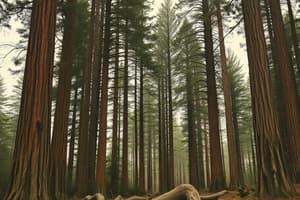Podcast
Questions and Answers
What is Dendrology?
What is Dendrology?
- Study of animals
- Study of fungi
- Study of soil
- Study of plants whose main support system is composed mainly of woody material (correct)
What is a tree?
What is a tree?
Woody plant with one central trunk
What is a shrub?
What is a shrub?
Plant with numerous woody stems
What is a vine?
What is a vine?
What is the canopy in a forest?
What is the canopy in a forest?
What is the understory?
What is the understory?
What does the shrub layer refer to in a forest?
What does the shrub layer refer to in a forest?
What is the ground layer in forests?
What is the ground layer in forests?
What is the Meristematic Zone?
What is the Meristematic Zone?
What are Ray Cells?
What are Ray Cells?
What is the main function of Parenchyma Cells?
What is the main function of Parenchyma Cells?
What is Heartwood?
What is Heartwood?
What is Sapwood?
What is Sapwood?
What does diameter refer to in terms of a tree?
What does diameter refer to in terms of a tree?
What is the radius of a tree?
What is the radius of a tree?
What is an Annual Ring?
What is an Annual Ring?
What does Taxonomy study?
What does Taxonomy study?
What is Binomial Nomenclature?
What is Binomial Nomenclature?
What is a Dichotomous Key?
What is a Dichotomous Key?
Study Notes
Dendrology Overview
- Dendrology is the study of trees and other woody plants, focusing on their structure and growth.
- Emphasizes the importance of woody material as the main support system in these plants.
Tree Types
- Tree: Characterized as a woody plant with a single central trunk, supporting a leafy canopy.
- Shrub: Defined as a plant with multiple woody stems, typically shorter than trees.
- Vine: A woody plant that grows by climbing or trailing and needs a support structure to thrive.
Forest Layers
- Canopy: The uppermost layer of a forest, consisting of the tops of trees that receive maximum sunlight.
- Understory: The layer beneath the canopy, which houses younger trees and plants that thrive in lower light conditions.
- Shrub Layer: Area in the forest where shrubs are more prominent than grasses and flowers, often providing habitat for various organisms.
- Ground Layer: The lowest layer of the forest, containing root systems, grasses, and flowering plants.
Cellular Structures
- Meristematic Zone: Regions in the tree where new cells are produced, crucial for growth, particularly found in root tips and twig buds.
- Ray Cells: Sheets of cells found in wood, extending from the inner bark towards the center of the tree, important for transporting nutrients.
- Parenchyma Cells: Cells focused on storing starch crystals, serving as a key energy reservoir for trees.
Wood Anatomy
- Heartwood: The central, non-living part of older trees, typically darker and denser than sapwood, providing structural support.
- Sapwood: The outer, younger layer of wood in a tree trunk, usually lighter in color and active in transporting nutrients.
Measurement Terms
- Diameter: Refers to the width across a circle, such as that of a tree trunk.
- Radius: The distance from the center of a circle or trunk to the outer edge, crucial for understanding tree size.
Growth Indicators
- Annual Ring: A ring-shaped layer of wood formed in a single growing season, useful for determining the age and growth conditions of a tree.
Taxonomy and Identification
- Taxonomy: The science of naming, describing, and classifying living organisms, essential for biological organization and study.
- Binomial Nomenclature: A two-part naming system (genus and species) used to provide a unique identification for organisms, facilitating scientific communication.
- Dichotomous Key: A tool that assists in identifying organisms through a series of binary choices, guiding users towards accurate classification.
Studying That Suits You
Use AI to generate personalized quizzes and flashcards to suit your learning preferences.
Description
This quiz covers the fundamentals of dendrology, exploring tree types, their structures, and the various layers of a forest ecosystem. Understand the differences between trees, shrubs, and vines, as well as the significance of each forest layer in supporting biodiversity.





